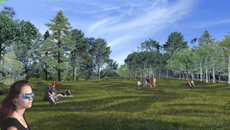Canadian landscape: A deferred invention
by Jean-Pierre Chupin, published 2006-09-01

We often say that Canadians, proud of their great spaces, are particularly sensitive to the quality of the landscape. Beyond clichés, occurrences are few and far between. Out of a total of nearly 180 inventoried competitions since 1945, there are less than ten devoted to landscape. However, there is not a lack of talented landscape architects. Why do we defer the invention of tomorrow's landscape?
In this belated September 2006 update, we present projects submitted for a competition in 2005 organized in Halifax. Twenty-six competitors presented a project during this competition's first stage, of which five were selected to further develop their ideas during a second stage (four Canadian teams and one Japanese team). It is important to mention that the jury, relying very (or overly) wisely on compromise, proposed that the services of two winning teams be used: the master plan prepared by NIP Paysages and the strategic management of Ekistics Planning and Design. Is it always necessary to choose the best of both worlds? The realization of this project will only tell, as organizers requested that the two teams work together: dissociating brains from brawn.
We equally invite internauts to discover, or rediscover, the many projects from different countries, that were submitted during the two competitions organized for the re-planning of the Montmorency Falls sector in Québec City in 2004. Entitled, "Perspective Littoral", this competition, that had professionals and students working in parallel, was astonishingly fruitful, and revealed an international interest in powerful sites. The unstructured environment of Montmorency Falls is indeed a blemish to the landscape: it is enlightening to compare Canadian and foreign attitudes towards comprehending territorial and cultural issues of such valuable (world?) heritage.
Please note that the Laboratoire d'étude de l'architecture potentielle has yet had the opportunity to document other competitions dealing with parks and gardens that were organized in Ontario, Alberta and British Columbia. We ask that all landscape architects interested in contributing to this archiving and communication endeavour, contact our research team (leap-lab@umontreal.ca).
Leaving the question of the deferral of landscape invention in Canada unresolved, we end by mentioning, once again, the beautiful project by Montreal architects at Atelier in situ for the visitor welcoming pavilions of the Jardins de Métis. The organization of this notable competition, having generated a form of "invention" itself in regards to its conceptual approach, invited all competitors to work on site, within the garden itself, during the summer of 1999. At the threshold of the 20th century, the "call of the landscape" could not have been clearer: "Architects, to the fields!"
In this belated September 2006 update, we present projects submitted for a competition in 2005 organized in Halifax. Twenty-six competitors presented a project during this competition's first stage, of which five were selected to further develop their ideas during a second stage (four Canadian teams and one Japanese team). It is important to mention that the jury, relying very (or overly) wisely on compromise, proposed that the services of two winning teams be used: the master plan prepared by NIP Paysages and the strategic management of Ekistics Planning and Design. Is it always necessary to choose the best of both worlds? The realization of this project will only tell, as organizers requested that the two teams work together: dissociating brains from brawn.
We equally invite internauts to discover, or rediscover, the many projects from different countries, that were submitted during the two competitions organized for the re-planning of the Montmorency Falls sector in Québec City in 2004. Entitled, "Perspective Littoral", this competition, that had professionals and students working in parallel, was astonishingly fruitful, and revealed an international interest in powerful sites. The unstructured environment of Montmorency Falls is indeed a blemish to the landscape: it is enlightening to compare Canadian and foreign attitudes towards comprehending territorial and cultural issues of such valuable (world?) heritage.
Please note that the Laboratoire d'étude de l'architecture potentielle has yet had the opportunity to document other competitions dealing with parks and gardens that were organized in Ontario, Alberta and British Columbia. We ask that all landscape architects interested in contributing to this archiving and communication endeavour, contact our research team (leap-lab@umontreal.ca).
Leaving the question of the deferral of landscape invention in Canada unresolved, we end by mentioning, once again, the beautiful project by Montreal architects at Atelier in situ for the visitor welcoming pavilions of the Jardins de Métis. The organization of this notable competition, having generated a form of "invention" itself in regards to its conceptual approach, invited all competitors to work on site, within the garden itself, during the summer of 1999. At the threshold of the 20th century, the "call of the landscape" could not have been clearer: "Architects, to the fields!"














